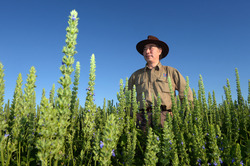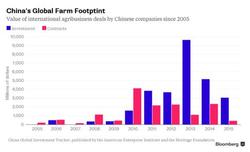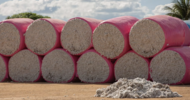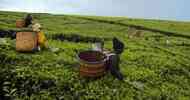
by Jason Scott
Yin Jian Zhong pulls off the felt cowboy hat protecting his head from the harsh north Australian sun as he stands in an irrigated field and points to a thin crop of black hair on his otherwise bald pate.
“I lost my hair when I was 35, but now it’s growing back,” the 57-year-old says, before grabbing a bushy green plant studded with small clusters of delicate purple flowers. “It’s because I’m now eating the seeds from this treasure.”
Yin is talking about chia, one of the so-called superfoods he’s growing on the Ord River floodplain, a remote Outback oasis, to sell in his homeland, China. The affable, whiskey-drinking former Shanghai policeman is the face of a $43 billion foreign farming frenzy by Chinese companies, spurred by mounting food security needs and a push to “go global.”

China, with a fifth of the world’s population, has only 7 percent of the planet’s arable land. Its state-owned and private companies are ramping up agriculture investments and contracts abroad, according to data compiled by China Global Investment Tracker. They have done agribusiness deals in more than 40 countries since 2005, with Australia, New Zealand and the U.S. attracting the highest number of major investments, the data show.
The list includes the $4.7 billion takeover of Virginia-based Smithfield Foods Inc., the world’s biggest producer of hogs and pork, by Shuanghui International Holdings Ltd. in September. State-owned Cofco Corp., China’s largest food company, has made investments totaling $1.85 billion in the U.S., Australia, Brazil and the Netherlands since 2008.
'Serious Challenges'
“There are big limits on China’s ability to grow what it needs domestically, so it’s looking more and more outside its borders for stable nations to expand agriculture,” said Mark Howden, a chief research scientist at the Commonwealth Scientific and Industrial Research Organisation. “Australia fits that bill even though some areas, such as in the north, create some pretty serious challenges.”
Yin’s company, Shanghai Zhongfu Group, agreed in 2012 to invest A$700 million ($511 million) in clearing and developing an expanse one-and-a-half times the size of Manhattan in the tropical East Kimberley region of Western Australia state.
In exchange, the Western Australian government agreed to lease Zhongfu’s local subsidiary Kimberley Agricultural Investment two parcels of land totaling 13,400 hectares (33,000 acres) for A$1 a year apiece for 50 years and to build infrastructure such as roads and irrigation channels.
Ord River
It’s part of the Ord River Irrigation Area, an Australian government-backed project started in the 1940s better known for its farming flops than successes: failed cotton crops, fungus-stricken rice and a sugar-cane farm and mill that CJ CheilJedang Corp., South Korea’s biggest food processor, abandoned in 2007.
Yin says he’s convinced the crocodile-inhabited area, about 2,250 kilometers (1,400 miles) northeast of state capital Perth, has the right climate, soil and water resources to become a food bowl. Besides chia, he’s growing sorghum and is considering putting in quinoa, the South American grain crop popularized by health-conscious hipsters.
It’s a new endeavor for Zhongfu, whose business interests include residential and commercial real-estate development in Shanghai, network communications and auctioneering.
After evaluating potential mining, port and other infrastructure projects in Australia, Yin discovered the Ord River project on his third visit to Western Australia, he says.
'Need to Eat'
“We can’t control the price of the minerals or demand, but with agriculture, the risk is relatively low because people always need to eat,” Yin says.
China overtook the U.S. in 2011 as the world’s largest importer of agricultural products and purchased $112.5 billion of goods in 2012, up from $11.7 billion in 2001. Prime Minister Tony Abbott is counting on an expanded Ord River project giving Australia a bigger share of that market as a mining boom peters.
Zhongfu indicated it may be willing to revive the sugar industry and recommission the mothballed mill when it won the bid for the leases in 2012. Yin says to make those plans work, the company needs more ground -- including land across the state border in the Northern Territory.
Northern Territory Chief Minister Adam Giles, whose government is negotiating with indigenous native-title holders for the expansion, says he’s a fan of Yin.
“He’s a very funny man,” Giles said in an interview in Darwin. “He’s out there fishing and hunting crocodiles.”
For Yin, who was wooed to the Australian Outback by Zhongfu founder Wu Pui Ngai, his former kung fu teacher, his story from 22-year police veteran to superfood farmer reflects that of modern China.
“We were at the bottom of society,” Yin says of his upbringing. “We have benefited from the change in China, the opening to the outside world. The living standard in China has been significantly increased, so there is more demand for good food.”













